Renewable energy is cheap as ever, but zoning isn’t keeping up with the market.

An article by Thor Benson for Popular Science reports on a key obstacle standing in the way of the kind of renewable energy development now possible at scale: zoning codes.
According to Benson, the amount of renewable energy projects is nowhere near commensurate to the economics of renewable energy.
The cost of renewable energy has plummeted over the past decade. The price of solar panels has decreased by roughly 90 percent over the past decade or so and the cost of wind power decreased by over half over that same period. With prices so low, it would be affordable to implement more solar and wind power in the United States than what we currently see.
While some states have fared better than others in rolling out renewable energy (California briefly achieved 100 percent renewable energy production earlier this month, for example), solar and wind power accounts for only 13 percent of the nation’s total energy production capacity, according to a recent report by the Americas for Bloomberg New Energy Finance. According to experts cited by Benson, the “soft costs” of permitting, zoning approvals, and construction are preventing higher levels of renewable energy production.
One 2020 study found getting a permit to install solar panels takes about 50 days on average, which is weeks longer than many other kinds of construction permits take. Wait times have slowly decreased over the past decade, but they remain a barrier.
Moreover:
Then there’s zoning laws…an area might not be zoned for installing renewable energy, which means you can’t install it unless your local government decides to allow it. A zoning ordinance might allow it to be installed but have requirements for where it’s allowed to be installed due to concerns about things like community aesthetics. It could even be entirely unclear if installing a renewable energy system is permissible at all.
Zoning codes in many U.S. cities were written long before climate change would make apparent the need to reduce greenhouse gas emissions from the power grid, or solar and wind energy became a possibility to located in local communities.
The source article, linked below, includes more details about how zoning laws prevent the development of renewable energy resources, and how some states and cities are revisiting zoning to respond to the need for more renewable energy capacity.
FULL STORY: Outdated zoning laws are holding renewable energy back

Analysis: Cybertruck Fatality Rate Far Exceeds That of Ford Pinto
The Tesla Cybertruck was recalled seven times last year.

National Parks Layoffs Will Cause Communities to Lose Billions
Thousands of essential park workers were laid off this week, just before the busy spring break season.

Retro-silient?: America’s First “Eco-burb,” The Woodlands Turns 50
A master-planned community north of Houston offers lessons on green infrastructure and resilient design, but falls short of its founder’s lofty affordability and walkability goals.

Test News Post 1
This is a summary

Analysis: Cybertruck Fatality Rate Far Exceeds That of Ford Pinto
The Tesla Cybertruck was recalled seven times last year.

Test News Headline 46
Test for the image on the front page.
Urban Design for Planners 1: Software Tools
This six-course series explores essential urban design concepts using open source software and equips planners with the tools they need to participate fully in the urban design process.
Planning for Universal Design
Learn the tools for implementing Universal Design in planning regulations.
EMC Planning Group, Inc.
Planetizen
Planetizen
Mpact (formerly Rail~Volution)
Great Falls Development Authority, Inc.
HUDs Office of Policy Development and Research
NYU Wagner Graduate School of Public Service




























